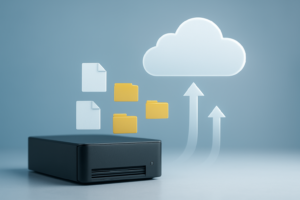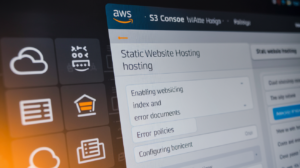Ever stood in front of your application architecture and thought, “Should I build up or build out?” You’re not alone. Tech leads everywhere face this scaling dilemma daily, and choosing wrong can cost thousands in wasted infrastructure.
I’m going to save you from that expensive mistake in the next few minutes.
When your system hits performance limits, understanding vertical vs horizontal scaling becomes essential. One adds more power to existing machines, the other adds more machines to your setup.
Both approaches work, but pick the wrong strategy and you’ll either overspend on unnecessary resources or create a maintenance nightmare that keeps your DevOps team working weekends.
So which scaling method actually makes sense for your specific workload? The answer might surprise you…
Understanding Scaling Fundamentals
The Growing Need for System Scaling in Modern Applications
As users flood in, your app starts gasping for air. That’s scaling in a nutshell – the art of handling growth without crashing and burning. Today’s applications face unprecedented demands: millions of users, terabytes of data, and zero patience for slowdowns. The days of building once and forgetting are long gone. Whether you’re running a scrappy startup or managing enterprise infrastructure, scaling isn’t optional anymore – it’s survival.
Key Performance Metrics That Indicate Scaling Requirements
Watch these warning signs like a hawk – they’re screaming that you need to scale:
- Response Time: When pages load slower than molasses in January
- CPU Utilization: Consistently above 70% means trouble brewing
- Memory Usage: Approaching capacity limits? Time to act
- Database Query Times: Queries taking forever? Users won’t wait
- Error Rates: Sudden spikes mean your system is buckling
Your metrics don’t lie. When numbers trend in the wrong direction, your infrastructure is waving white flags. The trick is catching these signals before users notice and abandon ship.
How Scaling Impacts Business Continuity and User Experience
Scaling isn’t just technical jargon—it directly hits your bottom line. When systems can’t handle load, customers bounce faster than you can say “server timeout.” A single second of delay can slash conversion rates by 7%.
Poor scaling creates a nasty domino effect:
- Frustrated users who never return
- Revenue losses during peak traffic (when you should be making the most money!)
- Brand damage that takes months to repair
- Competitive disadvantage as rivals with smoother experiences steal your customers
The flip side? Proper scaling means consistent experiences even during Black Friday-level traffic surges, building customer loyalty through reliability.
Common Scaling Challenges for Tech Teams
Tech teams face an obstacle course when scaling systems:
- Cost Management: Balancing performance needs against budget realities
- Legacy Architecture: Older systems weren’t built with massive scale in mind
- Data Consistency: Keeping information accurate across distributed systems
- Technical Debt: Quick fixes that become long-term nightmares
- Skill Gaps: Finding engineers experienced in large-scale architectures
The hardest part? Making crucial scaling decisions under pressure, often with incomplete information. Teams must navigate trade-offs between immediate fixes and sustainable solutions, all while keeping systems running. No wonder scaling keeps engineers up at night.
Vertical Scaling Explained
Definition and Core Principles of Vertical Scaling
Vertical scaling, or “scaling up,” means beefing up your existing server with more power. Think of it like upgrading your car’s engine instead of buying a second car. You’re simply adding more CPU, RAM, or storage to handle increased load. No code changes needed—just a bigger, badder machine doing the same job.
When Adding More Power to Existing Machines Makes Sense
Vertical scaling shines when simplicity matters more than infinite growth. Got a database that needs lightning-fast performance on a single node? Need a quick fix without rearchitecting your app? Scaling up delivers immediate results without the complexity of distributed systems. It’s perfect for applications with modest growth projections or workloads that aren’t easily distributed.
Cost Implications and ROI Considerations
The financial math of vertical scaling starts simple but gets complicated fast. Early upgrades deliver great bang for your buck—doubling RAM can instantly boost performance. But costs climb exponentially as you approach high-end hardware. A server with 8x the resources might cost 20x more. The ROI sweet spot typically exists in the middle range before hitting premium pricing territory.
Technical Limitations and Ceiling Effects
Every vertical scaling strategy eventually hits a wall. Even with unlimited budget, physics constrains what single machines can do. You’ll face motherboard limitations on RAM slots, CPU socket counts, and power/cooling challenges. Plus, scaling up creates bigger failure points—when that supercharged server crashes, everything goes down. Performance gains also diminish at the extreme end of the hardware spectrum.
Real-World Success Stories of Vertical Scaling Implementations
Medium-sized financial firms frequently leverage vertical scaling with impressive results. One investment company avoided a costly application rewrite by upgrading to enterprise-grade servers with 2TB RAM and 96 cores. Their transaction processing improved 400% without changing a line of code. Another success: an e-commerce platform handled Black Friday by temporarily scaling up database servers, avoiding complex sharding operations.
Horizontal Scaling Demystified
Breaking Down the Distributed Architecture Approach
Horizontal scaling isn’t rocket science—it’s about adding more machines to your resource pool instead of beefing up existing ones. Think of it as hiring more workers rather than training one employee to do everything. Each server handles a portion of the workload, creating a network that shares responsibilities. When traffic spikes, you simply add more servers to the mix.
Load Balancing and Resource Distribution Strategies
Smart load balancing is the secret sauce of horizontal scaling. Without it, some servers would sit idle while others crash under pressure. Round-robin distribution sends requests in sequence, while least connection methods favor servers handling fewer active connections. More sophisticated algorithms consider server capacity, response times, and even geographic location to optimize performance across your distributed system.
Elasticity Benefits for Fluctuating Workloads
The beauty of horizontal scaling? It breathes with your business demands. Unlike vertical scaling’s rigid limitations, horizontal architectures can expand and contract automatically. During Black Friday sales, spin up extra instances. During quiet periods, scale down to save costs. This elasticity is particularly valuable for businesses with unpredictable traffic patterns or seasonal fluctuations—giving you the agility to respond to market conditions without overprovisioning.
Common Implementation Challenges and Solutions
Horizontal scaling isn’t all sunshine and rainbows. Data consistency becomes tricky when information is spread across multiple machines. CAP theorem reminds us we can’t have perfect consistency, availability, and partition tolerance simultaneously. Session management requires thoughtful design—sticky sessions or centralized session stores help maintain user experiences. Database bottlenecks often emerge as pain points, but solutions like read replicas, sharding, and distributed caching can help overcome these hurdles.
Comparing Vertical vs Horizontal Scaling
Comparing Vertical vs Horizontal Scaling
A. Performance Differences Under Various Workload Types
Vertical scaling shines with CPU-intensive tasks like complex calculations, while horizontal scaling dominates I/O-heavy workloads such as web servers handling thousands of concurrent connections. The difference? Vertical scaling hits physical limits faster – you can only add so much RAM to a server before hitting motherboard constraints. Horizontal scaling, though more complex to implement, offers nearly limitless expansion potential.
B. Cost Analysis: Initial Investment vs Long-Term TCO
Vertical scaling typically requires higher upfront investment for premium, high-capacity hardware components. A single server with 128GB RAM and 24 cores costs significantly more than four servers with 32GB RAM and 6 cores each. However, the long-term total cost of ownership tells a different story:
| Cost Factor | Vertical Scaling | Horizontal Scaling |
|---|---|---|
| Hardware | Higher initial cost for premium components | Lower per-unit cost, scales incrementally |
| Power & Cooling | Lower overall for single server | Higher with multiple servers |
| Licensing | Often simpler (single server) | Can multiply with per-server licenses |
| Maintenance | Single point of maintenance | Multiple systems to maintain |
| Expansion | Expensive upgrades, potential downtime | Gradual, predictable scaling costs |
C. Scalability Limits: Where Each Approach Hits Walls
Vertical scaling inevitably encounters hard physical limitations. No matter how much you invest, you’ll eventually hit the ceiling of what a single server can handle—whether that’s CPU cores, memory slots, or I/O capacity. The performance gains also tend to follow a law of diminishing returns: doubling your server specs rarely doubles your performance.
Horizontal scaling’s limits are more theoretical than practical. While you might face network complexity, data consistency challenges, or application architecture constraints, the approach itself doesn’t have a fixed ceiling. Cloud providers have proven this by scaling applications across thousands of nodes.
D. Maintenance and Operational Overhead Comparison
The operational reality between these scaling approaches couldn’t be more different. Vertical scaling keeps things simple—one server means fewer points of failure, simplified backups, and straightforward monitoring. However, maintenance often requires complete system downtime.
Horizontal scaling introduces complexity through load balancing, synchronization, and distributed system management. You’ll need more sophisticated deployment strategies, monitoring tools, and potentially specialized staff. The upside? You can perform rolling updates with zero downtime, and individual node failures don’t bring down the entire system.
E. Fault Tolerance and Reliability Considerations
Vertical scaling creates inherent single points of failure—when your one powerful server goes down, everything goes down with it. Even with redundant components like power supplies and RAID arrays, you’re still vulnerable to system-wide failures.
Horizontal scaling practically builds fault tolerance into its DNA. With properly configured load balancing and redundancy, your application continues running even when individual nodes fail. This architectural advantage explains why most high-availability systems use horizontal scaling as their foundation—it simply provides better protection against unexpected outages.
Decision Framework for Choosing the Right Scaling Strategy
Decision Framework for Choosing the Right Scaling Strategy
A. Assessing Your Application Architecture Requirements
Choosing between vertical and horizontal scaling isn’t just a technical decision—it’s strategic. Your application’s architecture fundamentally dictates which path makes sense. Stateless services? Go horizontal. Heavy computational workloads on single threads? Vertical might be your answer. The right choice depends on what your application actually needs to thrive, not just what’s trendy in tech circles.
B. Budget Constraints and Resource Availability Factors
Money talks when scaling decisions happen. Vertical scaling often means higher upfront costs for those beefy machines, while horizontal scaling spreads costs over time but adds complexity. Your budget reality might force your hand regardless of what’s technically “best.” And don’t forget—sometimes the hardware you want simply isn’t available when you need it. Cloud options have expanded possibilities, but haven’t eliminated these fundamental tradeoffs.
C. Future Growth Projections and Their Impact on Scaling Decisions
Think about where your traffic is headed, not just where it sits today. If you’re expecting explosive growth, horizontal scaling gives you that runway without hitting ceilings. But steady, predictable growth might be perfectly served by occasional vertical upgrades. The mistake? Building for hypothetical millions before you’ve secured your first thousand users. Right-size your scaling approach to your actual growth trajectory.
D. Hybrid Approaches: Combining Vertical and Horizontal Scaling
The smartest teams don’t pick sides—they blend approaches strategically. You might vertically scale your database while horizontally scaling your web servers. This isn’t indecision; it’s optimization. Each component of your system has different needs and bottlenecks. The hybrid approach acknowledges this reality and lets you apply the right solution to each part of your architecture rather than forcing a one-size-fits-all strategy.
Implementation Best Practices
Implementation Best Practices
A. Starting Small: Incremental Scaling Approaches
Nobody jumps into full-scale infrastructure changes overnight. Smart teams start with baby steps. Pick a non-critical component, apply your scaling strategy there, and watch what happens. Each small win builds confidence and provides valuable lessons before you tackle mission-critical systems. This incremental approach minimizes risks while maximizing learning opportunities.
B. Monitoring Tools for Optimal Scaling Decisions
Your scaling decisions are only as good as your data. Tools like Datadog, New Relic, and Prometheus don’t just track performance—they tell the story behind your numbers. Set up dashboards that highlight key metrics: response times, resource utilization, and bottlenecks. When these tools flash warning signs, you’ll know exactly which scaling lever to pull and when.
C. Testing Strategies Before Full Deployment
The staging environment is your best friend when scaling. Create realistic load tests that mimic production traffic patterns and spikes. Simulate failure scenarios to verify your system’s resilience. Remember that theoretical scaling plans often crumble under real-world conditions, so test aggressively—break things in staging so you don’t break them in production.
D. Avoiding Common Pitfalls in Scaling Projects
I’ve seen countless teams fall into the same traps. They overscale too early (burning cash), underestimate database complexity, or forget about network limitations. Another classic mistake? Treating scaling as purely technical without considering operational impacts. Your brilliant auto-scaling solution means nothing if your team can’t maintain it or your monitoring can’t keep up.
E. When to Revisit and Revise Your Scaling Strategy
Scaling isn’t set-it-and-forget-it magic. Review your approach quarterly or after significant business changes. Has your user behavior shifted? Are new technologies available? Is your current solution costing more than anticipated? The perfect scaling strategy today might be completely wrong tomorrow, so build review cycles into your roadmap from day one.
Choosing between vertical and horizontal scaling is a critical decision that can significantly impact your application’s performance, cost-efficiency, and future growth potential. Vertical scaling offers simplicity and quick implementation for applications with predictable workloads and specific resource constraints, while horizontal scaling provides superior fault tolerance, flexible scalability, and often better cost management for applications experiencing variable traffic patterns. Your specific business requirements, budget constraints, and growth projections should guide this important architectural decision.
Remember that scaling strategies aren’t mutually exclusive—many successful systems implement hybrid approaches that leverage the strengths of both methods. Start by thoroughly analyzing your application’s workload characteristics, performance bottlenecks, and future growth trajectory. Whether you choose to scale up, scale out, or combine both approaches, ensure your scaling strategy aligns with your business objectives and is implemented using industry best practices for monitoring, automation, and continuous optimization.




















